Ford (NYSE:F) Delivers Strong Q4 Numbers But Stock Drops

Automotive manufacturer Ford (NYSE:F) reported Q4 CY2024 results topping the market’s revenue expectations , with sales up 4.9% year on year to $48.2 billion. Its non-GAAP profit of $0.39 per share was 20.4% above analysts’ consensus estimates.
Is now the time to buy Ford? Find out in our full research report .
Ford (F) Q4 CY2024 Highlights:
Company Overview
Established to make automobiles accessible to a broader segment of the population, Ford (NYSE:F) designs, manufactures, and sells a variety of automobiles, trucks, and electric vehicles.
Automobile Manufacturing
Much capital investment and technical know-how are needed to manufacture functional, safe, and aesthetically pleasing automobiles for the mass market. Barriers to entry are therefore high, and auto manufacturers with economies of scale can boast strong economic moats. However, this doesn’t insulate them from new entrants, as electric vehicles (EVs) have entered the market and are upending it. This has forced established manufacturers to not only contend with emerging EV-first competitors but also decide how much they want to invest in these disruptive technologies, which will likely cannibalize their legacy offerings.
Sales Growth
A company’s long-term sales performance can indicate its overall quality. Any business can put up a good quarter or two, but many enduring ones grow for years. Regrettably, Ford’s sales grew at a sluggish 3.5% compounded annual growth rate over the last five years. This fell short of our benchmark for the industrials sector and is a poor baseline for our analysis.
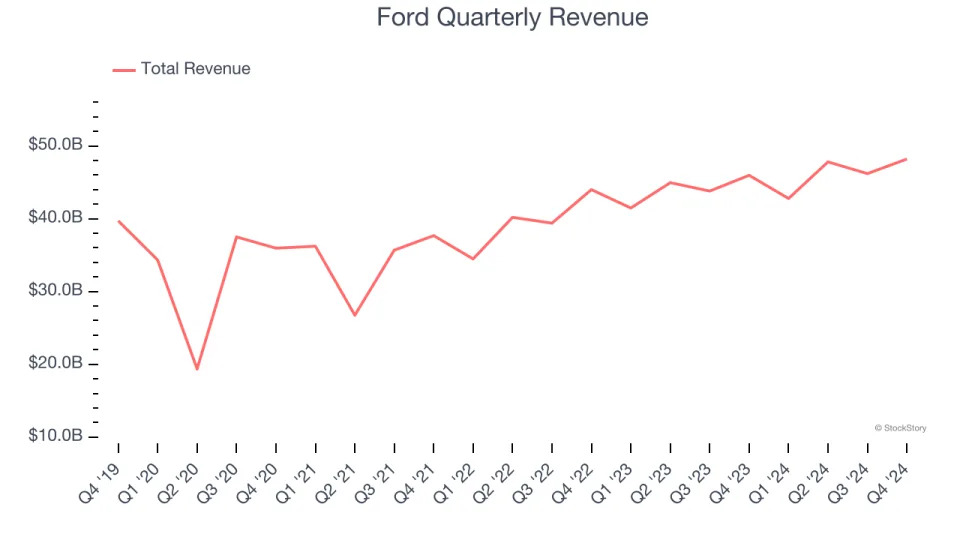
We at StockStory place the most emphasis on long-term growth, but within industrials, a half-decade historical view may miss cycles, industry trends, or a company capitalizing on catalysts such as a new contract win or a successful product line. Ford’s annualized revenue growth of 8.2% over the last two years is above its five-year trend, suggesting some bright spots.
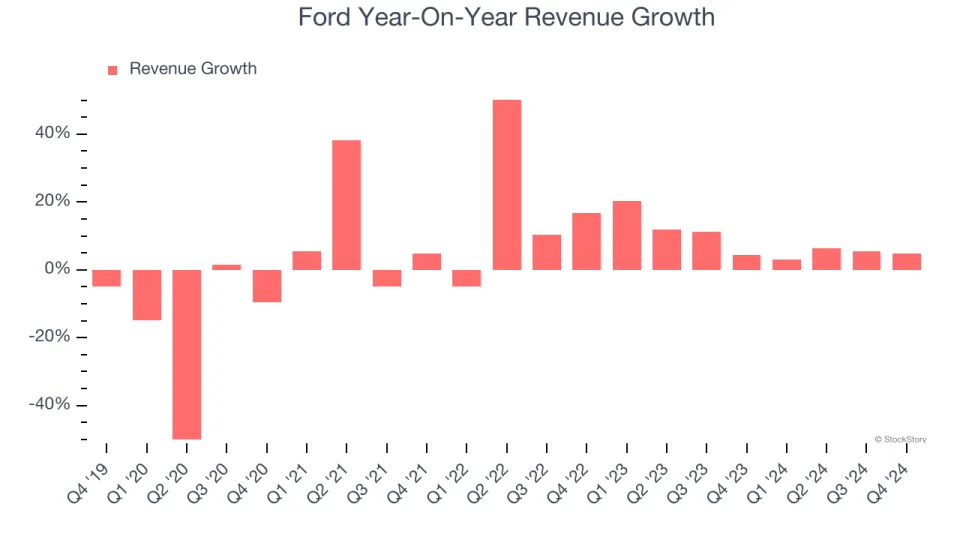
Ford also reports its vehicles sold, which reached 1.19 million in the latest quarter. Over the last two years, Ford’s vehicles sold averaged 2.9% year-on-year growth. Because this number is lower than its revenue growth, we can see the company benefited from price increases.
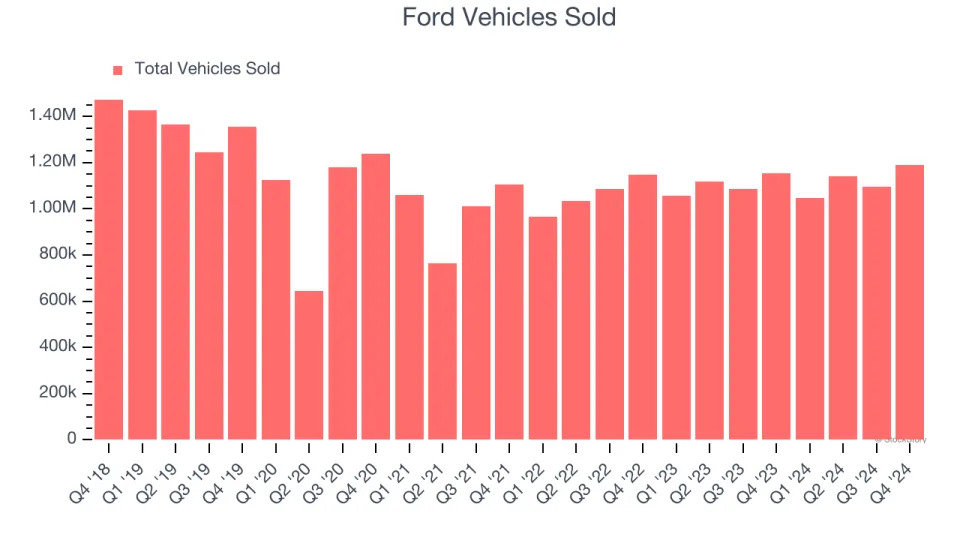
This quarter, Ford reported modest year-on-year revenue growth of 4.9% but beat Wall Street’s estimates by 5.5%.
Looking ahead, sell-side analysts expect revenue to decline by 5% over the next 12 months, a deceleration versus the last two years. This projection doesn't excite us and implies its products and services will face some demand challenges.
Here at StockStory, we certainly understand the potential of thematic investing. Diverse winners from Microsoft (MSFT) to Alphabet (GOOG), Coca-Cola (KO) to Monster Beverage (MNST) could all have been identified as promising growth stories with a megatrend driving the growth. So, in that spirit, we’ve identified a relatively under-the-radar profitable growth stock benefiting from the rise of AI, available to you FREE via this link .
Operating Margin
Operating margin is a key measure of profitability. Think of it as net income - the bottom line - excluding the impact of taxes and interest on debt, which are less connected to business fundamentals.
Ford was profitable over the last five years but held back by its large cost base. Its average operating margin of 2.3% was weak for an industrials business. This result isn’t too surprising given its low gross margin as a starting point.
On the plus side, Ford’s operating margin rose by 6.9 percentage points over the last five years.
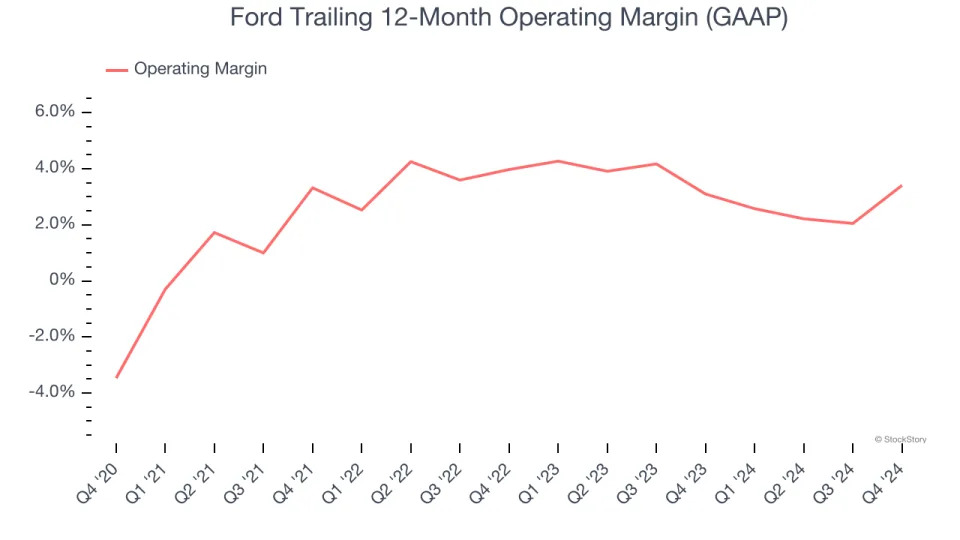
In Q4, Ford generated an operating profit margin of 4.8%, up 5.3 percentage points year on year. The increase was solid and shows its expenses recently grew slower than its revenue, leading to higher efficiency.
Earnings Per Share
Revenue trends explain a company’s historical growth, but the long-term change in earnings per share (EPS) points to the profitability of that growth – for example, a company could inflate its sales through excessive spending on advertising and promotions.
Ford’s EPS grew at a decent 9.2% compounded annual growth rate over the last five years, higher than its 3.5% annualized revenue growth. This tells us the company became more profitable on a per-share basis as it expanded.
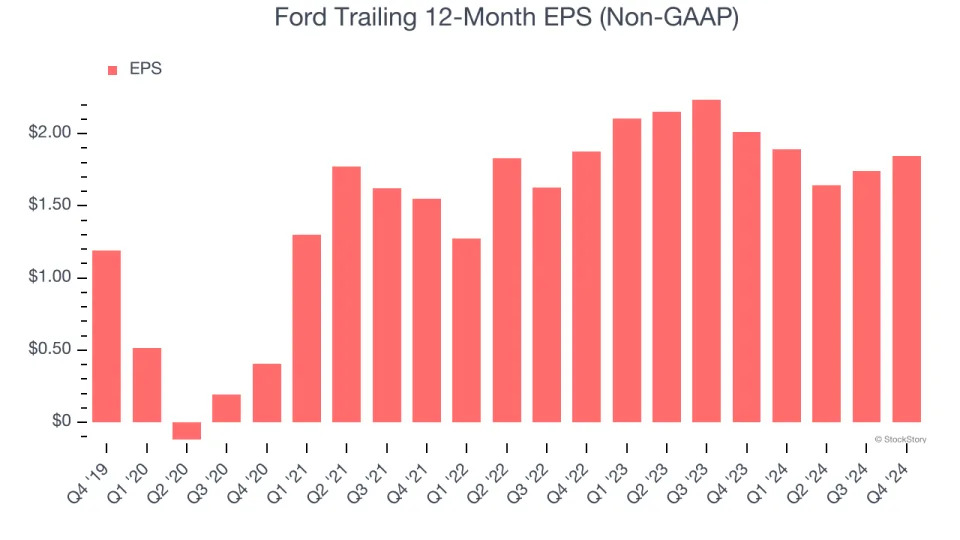
Diving into Ford’s quality of earnings can give us a better understanding of its performance. As we mentioned earlier, Ford’s operating margin expanded by 6.9 percentage points over the last five years. This was the most relevant factor (aside from the revenue impact) behind its higher earnings; taxes and interest expenses can also affect EPS but don’t tell us as much about a company’s fundamentals.
Like with revenue, we analyze EPS over a shorter period to see if we are missing a change in the business.
For Ford, EPS didn’t budge over the last two years, a regression from its five-year trend. We hope it can revert to earnings growth in the coming years.
In Q4, Ford reported EPS at $0.39, up from $0.29 in the same quarter last year. This print easily cleared analysts’ estimates, and shareholders should be content with the results. Over the next 12 months, Wall Street expects Ford’s full-year EPS of $1.85 to shrink by 10.5%.
Key Takeaways from Ford’s Q4 Results
We were impressed by how significantly Ford blew past analysts’ sales volume expectations this quarter. We were also excited its revenue outperformed Wall Street’s estimates by a wide margin. However, 2025 guidance threw some cold water on things. The outlook was in line to below expectations and “presumes headwinds related to market factors". This weighed on shares, and the stock traded down 5.3% to $9.47 immediately following the results.
Should you buy the stock or not? We think that the latest quarter is just one piece of the longer-term business quality puzzle. Quality, when combined with valuation, can help determine if the stock is a buy. We cover that in our actionable full research report which you can read here, it’s free .

